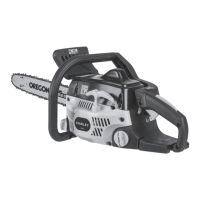9
SYMBOLS
DEVICES FOR REDUCING THE RISK OF
KICKBACK INJURY
Quickstop Chain Brake
WARNING: To reduce the risk of injury, stop using the
saw immediately if the chain brake does not function
properly. Take the saw to your local Service Centre! Do
not use the saw until the problem has been rectified.
Chain brake is designed to stop the chain in the event of
kickback. When the chain brake/hand guard is pushed towards
the bar, the chain should stop immediately. A chain brake does
not prevent kick-back, the chain brake should be cleaned and
tested daily.
Low Kickback Chain
“Low kickback saw chain” is a chain which has met the
kickback performance requirements. Low-Kickback Chain,
designed with a contoured depth gauge and guard link which
deflect kickback force and allow wood to gradually ride into the
cutter. This chainsaw is fitted with a low kickback chain.
Reduced Kickback Bar
Reduced-Kickback Guide Bar, designed with a small radius tip
which reduces the size of the kickback danger zone on the bar
tip. A Reduced-Kickback Guide Bar has been demonstrated to
significantly reduce the number and seriousness of kickbacks.
This chainsaw is fitted with a low kickback bar.
Warning. See
instruction
handbook.
Appropriate ear, eye
and head protection
must be worn.
Hot surfaces will
burn fingers or
palms.
Gloves with saw
protection.
Keep safety distance
between user and
machinery
Boots with saw
protection, steel
toe-cap and non-slip
sole.
No open fire. No smoking.
Kickback: Never cut
with the tip of the
chainsaw.
Always grip the machine
with two hands
To Avoid Kickback
The best protection from personal injury that may result from
kickback is to avoid kickback situations.
1. Hold the chainsaw firmly with both hands and maintain a
secure grip.
2. Be aware of the location of the guide bar nose at all times.
3. Never let the nose of the guide bar contact any object. Do
not cut limbs with the nose of the guide bar.
Be especially careful when cutting small, tough limbs, small
size brush and saplings which may easily catch the chain.
4. Don’t overreach.
5. Don’t cut above shoulder height.
6. Begin cutting and continue at full throttle.
7. Cut only one log at a time.
8. Use extreme caution when reentering a previous cut.
9. Do not attempt to plunge cut if you are not experienced with
these cutting techniques.
10. Be alert for shifting of the log or other forces that may cause
the cut to close and pinch the chain.
11. Maintain saw chain properly. Cut with a correctly
sharpened, properly tensioned chain at all times.
12. Stand to the side of the cutting path of the chainsaw.
Engage: push to
forward position
Disengage: pull
back to locking
position

